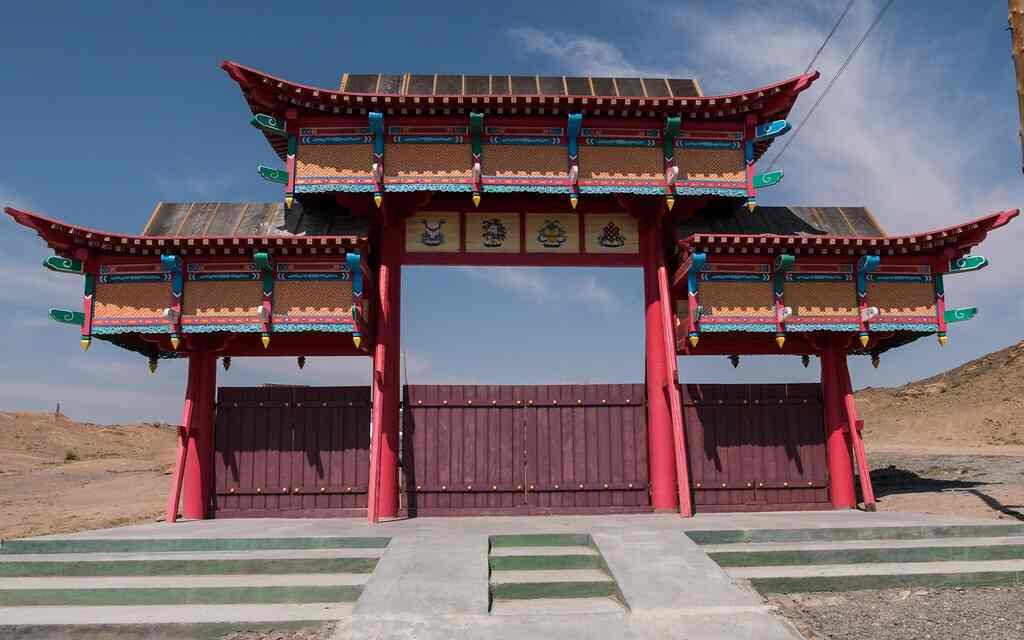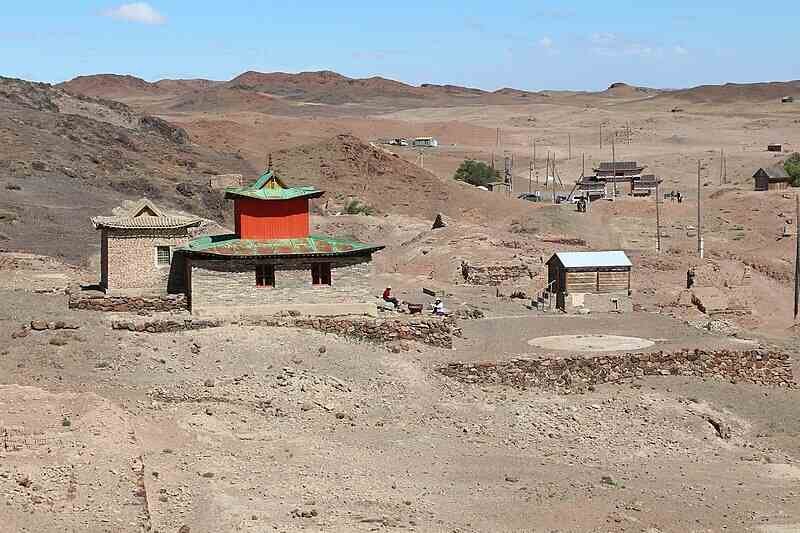Mongolia, a land of vast steppes and rugged mountains, holds within its boundaries not only natural beauty but also centuries-old spiritual traditions. One of the most significant pieces of its cultural heritage is Ongi Monastery, a serene yet historically profound symbol of Mongolian Buddhism.
Located on the banks of the Ongi River, this monastery offers a captivating look into the history, culture, and religion of the country. Though its ruins now evoke a melancholic sense of a bygone era, Ongi Monastery continues to draw pilgrims and tourists alike who seek a deeper understanding of Mongolia’s spiritual landscape.

Ongi Monastery history
Founded in 1660, Ongi Monastery was originally composed of two distinct temple complexes situated on either side of the Ongi River: Khutagt Monastery on the south bank and Barlim Monastery on the north bank.
At its zenith, the monastery could accommodate over 1,000 monks and included four Buddhist universities, making it one of the largest monastic complexes in Mongolia. The southern complex featured 11 temples, while the northern complex boasted 17 temples, among which was one of the largest temples in Mongolia.
The monastery flourished for over two centuries until the rise of communism in Mongolia during the 1930s. In 1939, under the leadership of Khorloogiin Choibalsan, a campaign against religious institutions led to the complete destruction of Ongi Monastery.
More than 200 monks were killed, while many survivors faced imprisonment or were forced into military service. The monastery’s buildings were razed, and the water from the Ongi River was diverted for industrial purposes, leading to the abandonment of surrounding communities.
Revival and Modern Significance
In recent years, following the democratization of Mongolia in 1990, efforts have been made to revive this important cultural site. In 2004, a new temple was inaugurated by returning monks who had once studied there as children.
a small museum has been established to showcase artifacts and educate visitors about the monastery’s history. Today, visitors can explore the ruins and witness ongoing restoration projects aimed at revitalizing the monastery.

Architectural Features
Ongi Monastery is set against a stunning backdrop of rugged mountains and expansive grasslands typical of the Gobi Desert region. The Ongi River flows nearby, adding to the area’s natural beauty. This picturesque setting provides opportunities for various outdoor activities such as hiking and camping.
The remaining structures at Ongi Monastery showcase a blend of traditional Mongolian and Tibetan architectural styles. Key features include:
Temples: The ruins include remnants of both Khutagt and Barlim Monasteries, with several temples still standing.
Stupas: A tall stupa remains as one of the few structures not completely destroyed during the purges.
Administrative Buildings: Various administrative structures can be found among the ruins, hinting at the monastery’s former organizational complexity.
Visitors can also find a small museum housed in a traditional ger (yurt), displaying artifacts recovered from the site along with items significant to Mongolian Buddhism.

How to Visit Ongi Monastery
Ongi Monastery is located in the Dundgovi Province of Mongolia, and reaching it can be a challenge due to its remote location. However, for those seeking to explore Mongolia’s spiritual and historical roots, the journey is well worth the effort.
How to Visit Ongi Monastery from Ulaanbaatar?
Visiting Ongi Monastery from Ulaanbaatar is a journey that takes you through some of Mongolia’s most stunning landscapes. Here’s a detailed guide to help you plan your trip:
Distance and Travel Time
Ongi Monastery is located approximately 550 kilometers (about 340 miles) south of Ulaanbaatar. The journey typically takes around 8 to 10 hours by car, depending on road conditions and stops along the way.
Travel Options
1. By Car:
Self-Drive: Renting a car is a popular option for those who prefer flexibility. Ensure you have a reliable vehicle, preferably a 4×4, as some roads can be rough and unpaved.
Private Driver: Hiring a private driver or a taxi can be more convenient if you’re not comfortable driving. This option allows you to relax and enjoy the scenery.
2. Guided Tours:
Several tour operators in Ulaanbaatar offer guided tours to Ongi Monastery. These tours often include transportation, meals, and accommodation, making them a hassle-free option. Look for tours that provide knowledgeable guides who can enrich your experience with historical and cultural insights.
Route and Stops
Route: The most common route is to head south from Ulaanbaatar towards the Dundgovi Province. The journey takes you through the scenic Gobi Desert, offering breathtaking views and opportunities to explore other attractions along the way.
Stops: Consider stopping at places like the **Baga Gazriin Chuluu** (a picturesque granite rock formation) and **Tsagaan Suvarga** (a stunning white stupa) to break up the journey and enjoy more of Mongolia’s natural beauty.
Accommodation
Ger Camps: Near Ongi Monastery, you can find traditional ger camps that offer a unique and authentic Mongolian experience. These camps provide basic amenities and a chance to experience the nomadic lifestyle.
Hotels: In nearby towns like Saikhan-Ovoo, there are a few small hotels and guesthouses. Booking in advance is recommended, especially during peak tourist seasons.
Practical Tips
Weather: The best time to visit is during the spring (April to June) and autumn (September to October) when the weather is mild. Summers can be hot, and winters are extremely cold.
Supplies: Bring plenty of water, snacks, and sunscreen. The remote location means amenities are limited.
Clothing: Wear comfortable, sturdy shoes for walking and exploring the ruins. Layered clothing is advisable to adjust to changing temperatures.
Respect: As a site of historical and spiritual significance, it’s important to be respectful. Follow any guidelines provided by local guides or signs at the site.
♣♣You May Also Like: ⇓
- Erdene Zuu Monastery, Mongolia: A Vibrant Heritage
- Tremendous Sukhothai, Thailand: A Rich Historic Hub
- Colorful Wat Arun: Beautiful Temple of Dawn in Thailand
- Outstanding Yasaka Pagoda: A Timeless Landmark in Kyoto
- Remarkable Blue Temple of the Chiang Rai, Thailand
Conclusion
Ongi Monastery, with its profound history, cultural significance, and ongoing reconstruction efforts, stands as a powerful symbol of **Mongolia’s spiritual resilience**. Its ruins tell the story of a rich Buddhist heritage that was nearly lost, while the new temples represent the enduring spirit of faith and tradition.
For anyone seeking to connect with Mongolia’s past and present, a visit to Ongi Monastery offers a rare and enlightening experience, deepening one’s appreciation for the country’s spiritual heritage.
FAQs:
1. What is Ongi Monastery?
Ongi Monastery is a historic Buddhist monastery located in Dundgovi Province, Mongolia, known for its ruins and rich cultural heritage.
2. When was Ongi Monastery founded?
The monastery was founded in 1660 and was one of the largest in Mongolia at its peak.
3. Is Ongi Monastery still active today?
While the original structures are in ruins, efforts to restore the monastery have been made since the 1990s.
4. Are there accommodations near Ongi Monastery?
Yes, there are tourist camps and ger accommodations available near the monastery.
5. Is there an entrance fee for visiting Ongi Monastery?
Typically, there is no entrance fee for exploring the ruins; however, donations for restoration efforts are appreciated.
6. Can I take photographs at Ongi Monastery?
Yes, photography is allowed and encouraged to capture the beauty of the ruins and surrounding nature.
7. Are there guided tours available at Ongi Monastery?
Yes, several tour operators offer guided tours that include visits to Ongi Monastery along with other attractions in the Gobi region.
8. Is there a museum at Ongi Monastery?
Yes, there is a small museum located in a ger that displays artifacts related to the monastery’s history.
9. Can I camp near Ongi Monastery?
Yes, camping is allowed in designated areas near the monastery for those seeking an outdoor experience.
10. What wildlife can I expect to see around Ongi Monastery?
The area is home to various wildlife species typical of the Gobi Desert region, including birds and small mammals.